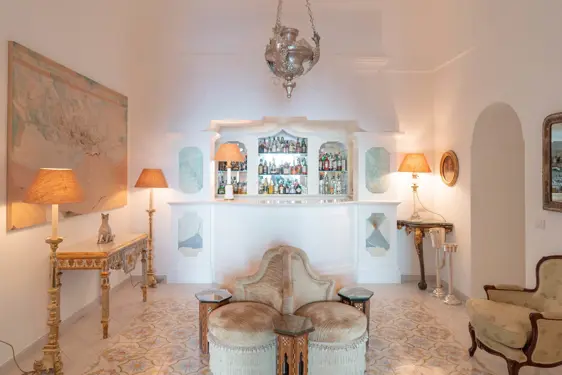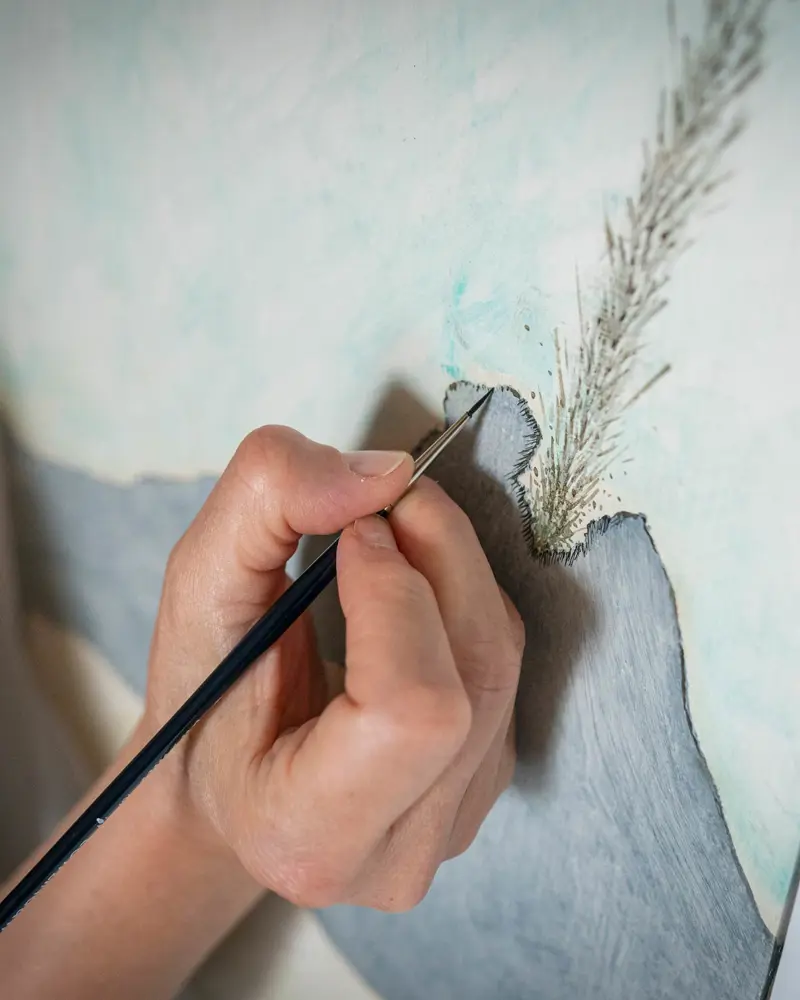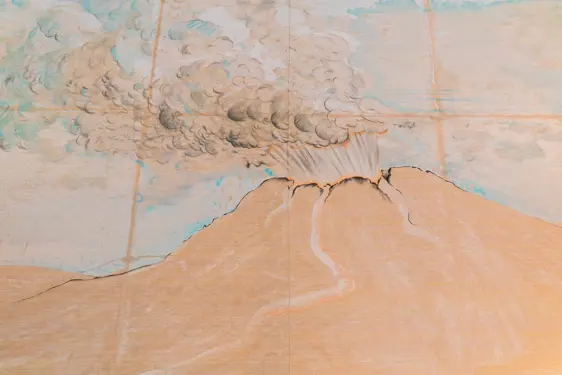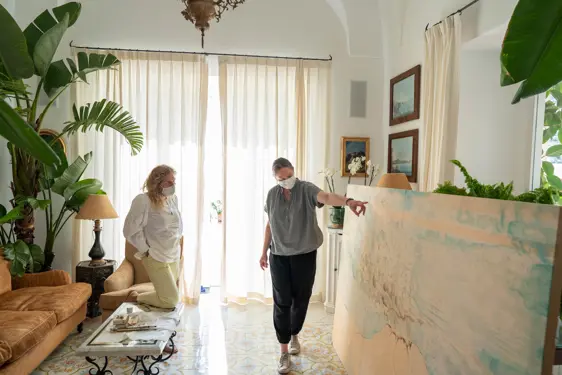CARAGH THURING: WHAT LIES BENEATH
04.10.2020 ART & CULTURE
In the late 18th century, northern European painters and writers flocked to the Bay of Naples, drawn in part by the awful thrill of Vesuvius, which was particularly active in those years, but also by the story of Pompeii’s destruction, then coming to light thanks to excavations sponsored by the Bourbon ruling family. The subterranean forces of the earth were, for these artists, potent metaphors for the creative impulse. As often, we rely on Goethe for an ironic take on this fashion for the sublime, for the frisson provoked by nature’s terrors. “The world has seen many disasters”, he noted in his diary à propos of Pompeii, “but few have brought such happiness to posterity”.

View
Though protected by the high ridge of the Monti Lattari from the superheated pyroclastic gas surge that killed so many Pompeii residents in an instant, Positano was not spared the other effects of the eruption of AD 79. Molten rock, pumice and hot ash was thrown up to 21 miles into the air, and prevailing winds caused it to hail down all along the Amalfi Coast. Then came torrential rains, which in turn provoked mudslides. The town’s recently excavated Roman villa bears eloquent witness to this storm of destruction: one of its painted walls split in two under the weight of the rocks and mud that accumulated on its landward side.
The work of Belgian-born artist Caragh Thuring, who lives and works in London and Scotland, Eruzione del 2020 adds three volcanoes to an ambience that is full of them. The late Franco Sersale, whose outgoing personality and roving curiosity still penetrates every corner of Le Sirenuse, collected, among many other things, Neapolitan prints of eruptions of Vesuvius, especially from the golden years of the genre between the end of the 18th and the beginning of the 19th century. At home in London, Thuring – who never met Franco – has a similar collection.
A graduate of the school of arts at Nottingham Trent University, Thuring has been exhibiting her work since 2006 and is represented in the permanent collections of – among other institutions – London’s Tate Gallery and the Albright-Knox Art Gallery in Buffalo. She is represented by Thomas Dane, in whose Naples gallery she held an absorbing 2019 show – one that was only partly about volcanoes.

After leaving art school, Thuring tells the Sirenuse Journal, she didn't make art for nine years. Instead, she found herself running a gallery. But one day she realised that she was, as she says, “on the wrong side of this”, and decided to start over. The very first image she painted was a volcano. It was the most spontaneous, unforced thing she could think of. “I always enjoyed drawing cross-sections of volcanoes as far back as primary school” she explains, adding “I’ve always been fascinated by their subterranean mystery, and the fact that they destroy themselves as well as build themselves from underneath”. They’ve returned frequently in her work in the fifteen years since then, alongside other recurring motifs.

View
Volcanoes, Thuring believes, represent “a kind of perversity of contradictions... there's a relentless fascination with them and the beauty of them even when they're erupting. It's such a complex set of scenarios and emotions and functions. It represents so many different things – it's sexual, it's physical, it's geological, it's visual. It embodies so much and with so much energy”.
Chief among the artist’s other visual touchstones are bricks – and submarines. Thuring saw plenty of the latter while growing up on the Scottish coast not far from the since-decommissioned US naval base in the inlet of Holy Loch. She takes up the story: “I would be in this beautiful landscape that was very dramatic, and then you’d suddenly see this matt black thing rising out of the water. It was very mysterious: you don’t know what’s going on down there, there’s this thing that you never see and then occasionally it rises up”. Thuring sees a close parallel between these strange acquatic emergences and the volcanic strand in her work, and curator Silka Rittson-Thomas agrees, pointing out that the submarines were “bubbling under like lava”. Before either of us can ask the next obvious question, the artist makes the connection with the bricks that often appear in her work as ribbons or chunks arranged in the decorative or structural patterns builders call ‘bonds’. “Brick to me is the most brilliant example of something that's natural and man-made”, she says. Bricks, she explains, come out of the earth, but are then used to create manufactured structures on the earth's surface. “Its’ the same thing” she concludes, “as a volcano building itself, coming out from the earth and building itself into this shape, this cone”.
She thought “this corner needs attention!”, and also loved the cheeky parallel between images of volcanic eruptions and the champagne bottles on the shelf behind the bar. And the stylish clutter of the hotel’s existing art and antiques didn’t bother her at all. “It's so dull”, she muses, “when you go to private collections and you see art slapped around the walls in a space that's made to look like a gallery. Some of the best collections I've seen in my life have been in people's houses where it's completely chaotic and everything's wedged in at all different angles”.
The four smaller paintings on gesso were also conceived as soon as Thuring saw the room. There was a contrast, she realised, between the depth of the bar niche with its bottle-lined shelves and the flatness of the all-white mouldings in the columns that framed it. “I realised that painted inserts could activate the space”, the artist says. Especially, she decided, if the gesso panels were pushed together in her studio and painted as if they were a single work, then pulled apart prior to installation.

View
The larger painting on the side wall is not a ‘canvas’ in the literal sense of the word. It’s painted on specially-woven cloth – a technique Thuring has used recently to bring extra layers to the image, to build other hands and histories into her work. In the past, the stretched cloths she painted on have incorporated reproductions of her own previous works carried out by skilled weavers, but in this case the background motif is based on some maiolica tiles that the artist came across on benches in the courtyard of Santa Chiara convent in Naples. Blown up much larger than life-size, it was woven into cotton-linen fabric on huge traditional looms by a company in Suffolk whose main activity is to make silk fabrics, often for historical projects.
And the china dog that sits on the ornate side table beneath the painting? “That was somewhere else in the hotel”, Thuring laughs. “As soon as I saw him I thought, ‘he needs to be under my painting’.” Looking around the room, Rittson-Thomas points out the uncanny match with the colour-scheme of the floor tiles, the lamps that flank the main painting, and even the burnished upholstery of the antique four-seater conversation settee in the centre of the room. “None of it was planned that way”, Thuring reveals. “It's quite uncanny how well it fits in”.
Artist and curator both stress the naturalness with which the old and new rub along together at Le Sirenuse. “They don't have to overwrite anything else”, Rittson-Thomas comments, “they all live together”. Thuring takes the ball and runs with it into a mindspace that is characteristic of this curious, restless, questing artist and her work: “I think it’s really important to allow all that time to be condensed into one environment”, she states with conviction. “It's always about language, or that interaction between different objects, different symbols, different situations or humours. It's all connected”.
Photos © Roberto Salomone
Le Sirenuse Newsletter
Stay up to date
Sign up to our newsletter for regular updates on Amalfi Coast stories, events, recipes and glorious sunsets





